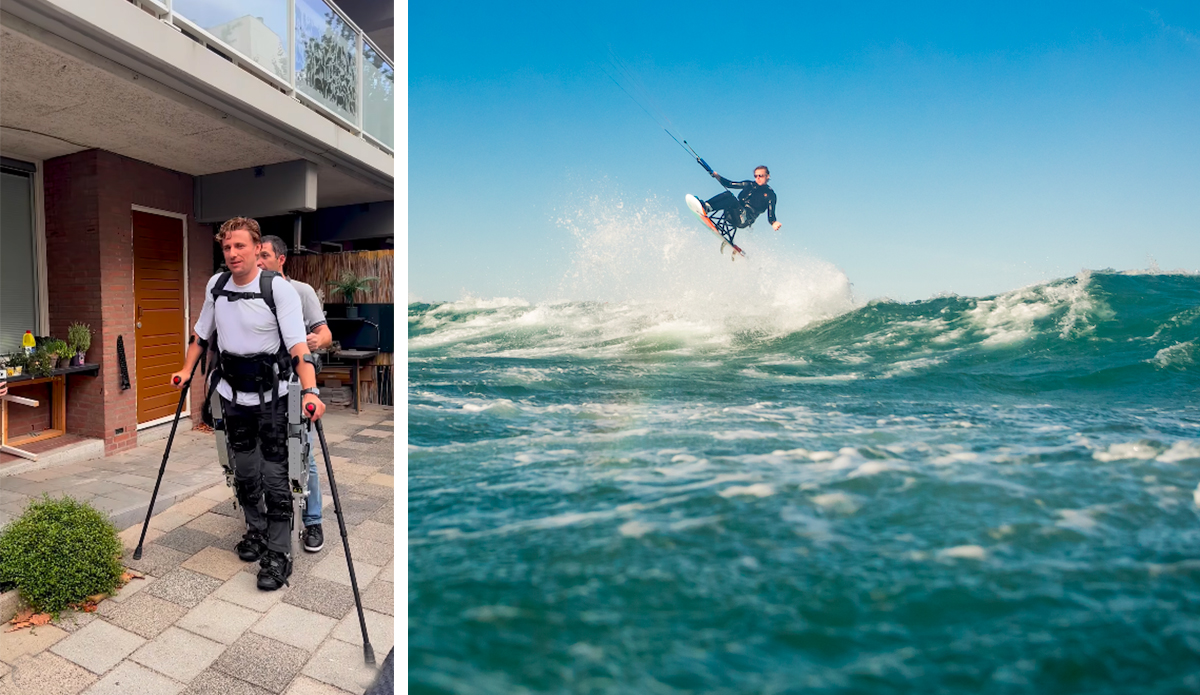Pure grit: Willem Hooft learned to kitesurf when the odds were seriously stacked against him. Photo: Svetlana Romantsova
In 2019, Willem Hooft was flying through the air, powered by the wind, peering down at the spray rearing off the waves in the electric cold blue of the Cape Town coast. Two years previously, to the day, he had been lying flat on the highway asphalt, with two pierced lungs and all his ribs broken. His brain screamed at him to move from the threat of the oncoming traffic. His body didn’t respond. He was paralyzed from the waist down.
The Dutch engineer had been on his commute to work on his motorbike when the car in front braked suddenly. He swerved, missed the vehicle, only for the car behind him to hit him at speed. He was launched 41 meters (as it was measured exactly in the report) forward, and landed on his back, damaging the Thoracic nerve (T12.) He would never walk again. Until this month.
“ExoAtlet reached out to me via Instagram and asked me to try out the exoskeleton and share my honest experience with my followers,” Hooft told The Inertia. “I had my first session with the suit last Monday, and standing upright again after all these years — stretching out fully, towering over everyone for a change, and walking a lap through the garden — was an incredible feeling. It was the first time in eight years that I’ve actually walked outside. That alone was worth everything.” (You can see video of his first walk here.)
The exoskeleton has a price tag of around $115,000, but the company has a new rental program aimed at making this technology accessible to a much wider group. The tool won’t be a replacement for his wheelchair, but is designed to aid joint health, bone density, circulation, muscle activation, and even organ function. It’s early days, but it’s a technology that could revolutionize those living with disabilities
In the intervening years since his accident, Hooft hadn’t exactly been waiting around for advancements in exoskeleton robotics to improve his life. Almost immediately after the accident in the early phases of rehab, the keen windsurfer set himself a series of goals.
“After my motorbike accident, I had to let go of many things, but one thing I could not and did not want to accept was the thought of never being able to surf again. I wanted to learn to kitesurf, and I wanted to do it in the waves of South Africa,” he said.
These goals were lofty. He was told that kitesurfing was too difficult to learn and that the risks were too great. That’s probably why there were only about eight paraplegics in the world doing it — each building their own board and rig.
Using $15,0000 in money from crowdfunding, Hooft set about building his own board, adapted a seat from a sit-skier set up in France, had a chair purpose-built in Denmark and used straps from a local sailmaker to attach it all together. He spent the next two years learning his new machine and developing safety techniques in the sea and in the pool to deal with any of the circumstances that come with traveling in the ocean at speed without the use of his legs.
Two years later, he was flying through the Cape Town air. In 2021, again in Cape Town, he set a new world sit-kiteboarding record with a 10-meter-high jump. “In a wheelchair, you’re always limited by your environment. But out on the water — gliding across the surface or flying through the air — those limits disappear,” he said. “Last year, I broke the 11-meter mark for the first time. Who would have thought that was even possible after being told I’d never walk again?” He now has his sights set on the 15 meter mark.

Hooft and his custom kite setup. Photo: Ryan Osmond
It, obviously, hasn’t been easy. He says that living in a body that no longer works the way it’s supposed to comes with complications, frustrations, and moments of confrontation. “But that’s something I can’t change,” he said. “These are the cards I’ve been dealt. What I can change is how I choose to play them. I’ve learned that so much is still possible — if you dare to dream big, set a clear goal, and commit to it fully.”
He has become a successful motivational speaker and founded the Willem Hooft Foundation. It organizes events and surf camps specifically for people in wheelchairs or with physical disabilities, helping them learn how to kitesurf. It has also become a global hub for information about the sport. He estimates there are now between 80 and 100 sit-kitesurfers around the world, an exponential growth up from the single digits when he started.
“My dream is to see the sport continue to expand and to help more people experience that same feeling of freedom I found on the water,” he concluded. “I said it eight years ago: I may never walk again, but I’ll learn how to fly.” This week, he did both.
